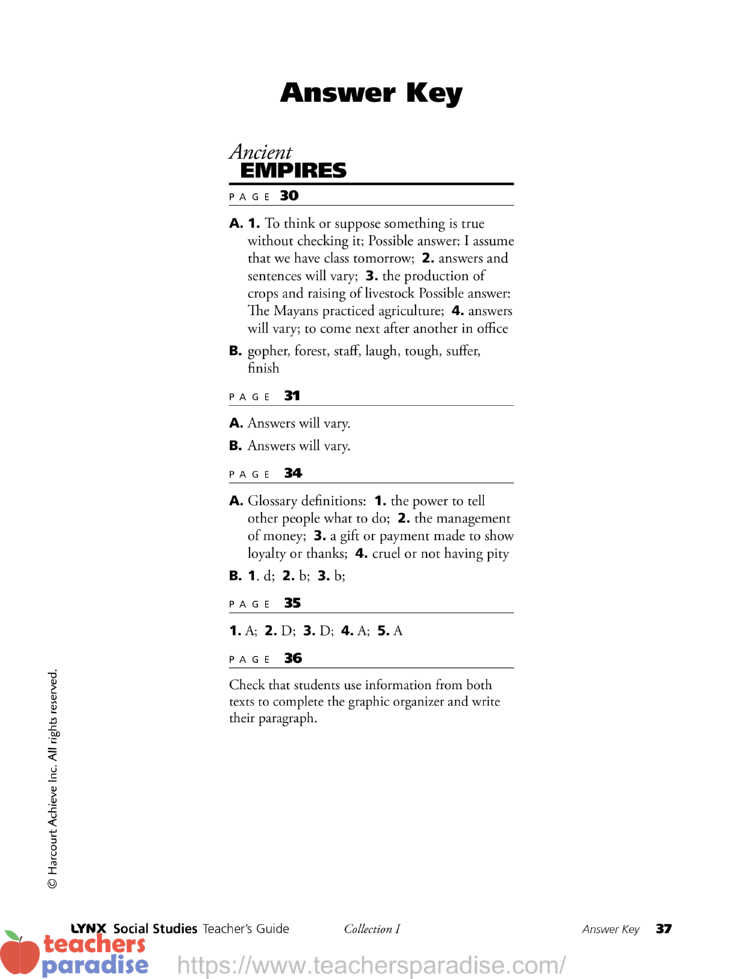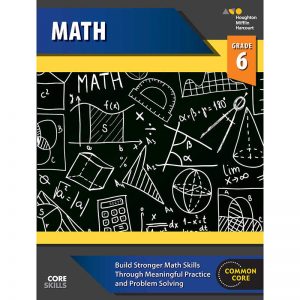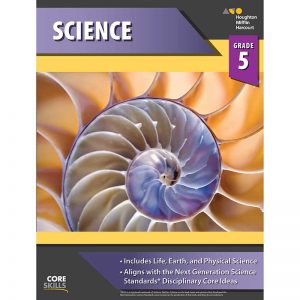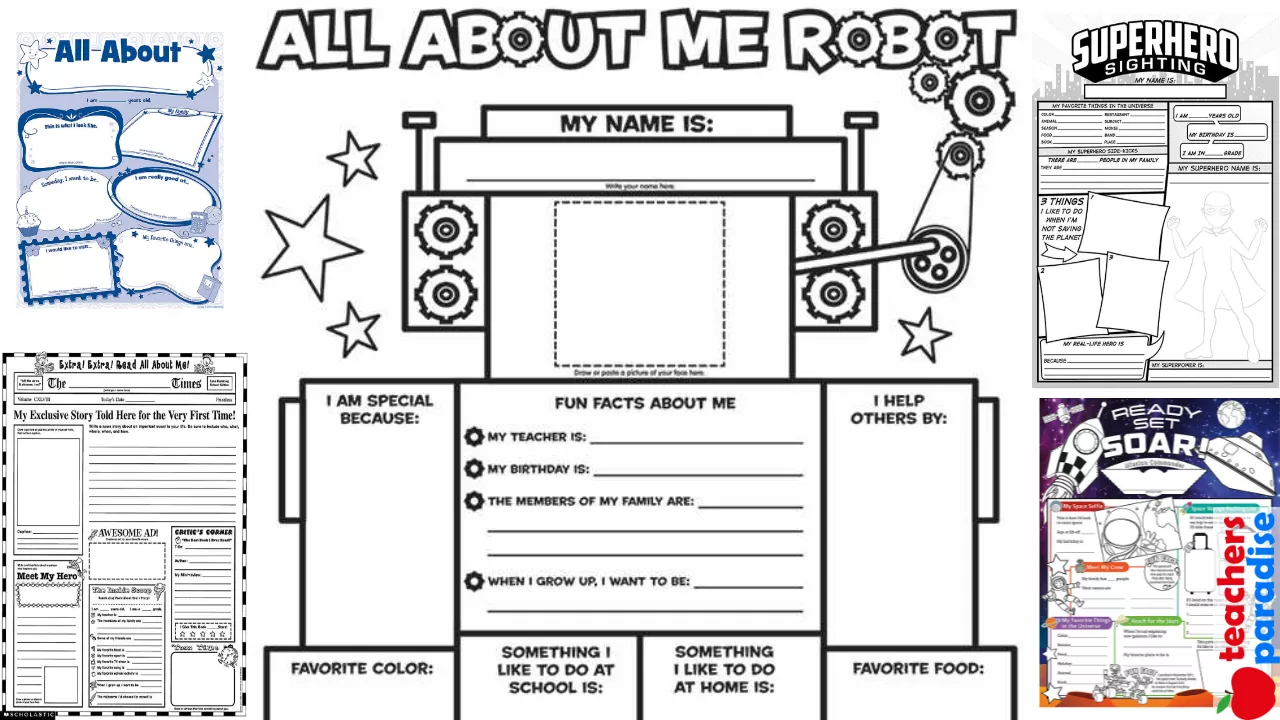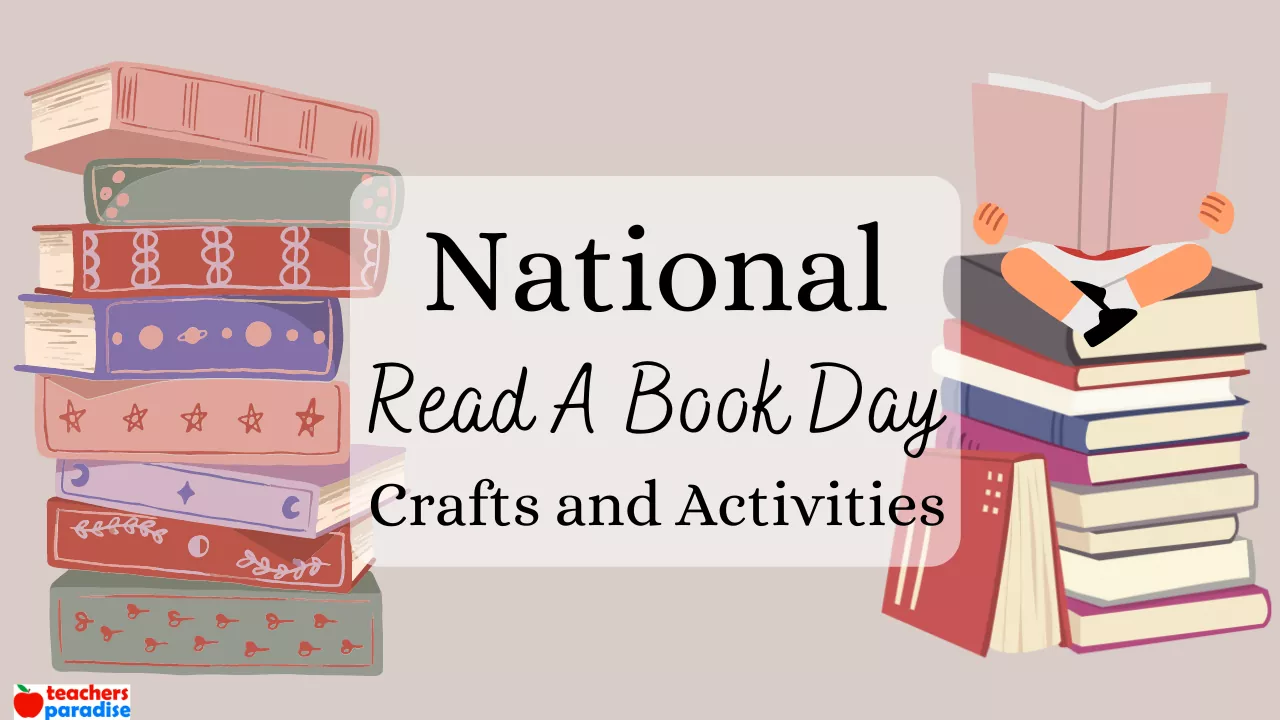Ancient Empires – Social Studies Teacher’s Guide
GRAPHIC NOVEL
Summary
More than 3,000 years ago, Tutankhamen ruled ancient Egypt as its pharaoh, or king. While still a teenager, Tut died under mysterious circumstances. In the 1920s, archaeologist Howard Carter discovered Tut’s treasure-filled tomb.
NONFICTION BOOK
Summary
Three great civilizations once lived in Mesoamerica (Central America): the Olmecs, the Maya, and the Aztecs. Each practiced agriculture and trade, and created impressive artwork. By the early 1500s, all three were gone.
Links to Social Studies
Why History Matters
Major events have shaped the development of various cultures.
World History
- Ancient Egypt was one of the world’s first great civilizations. 2. Complex civilizations developed in Mesoamerica.
WORKSHEET & Sample PDF Activity
[adinserter block=”2″]
Sample PDF Activity
[adinserter block=”3″]
Geography
An understanding of geography can help people interpret events from the past and understand cultures.
American History
There were similarities between the early societies of the Americas and Ancient Egypt.
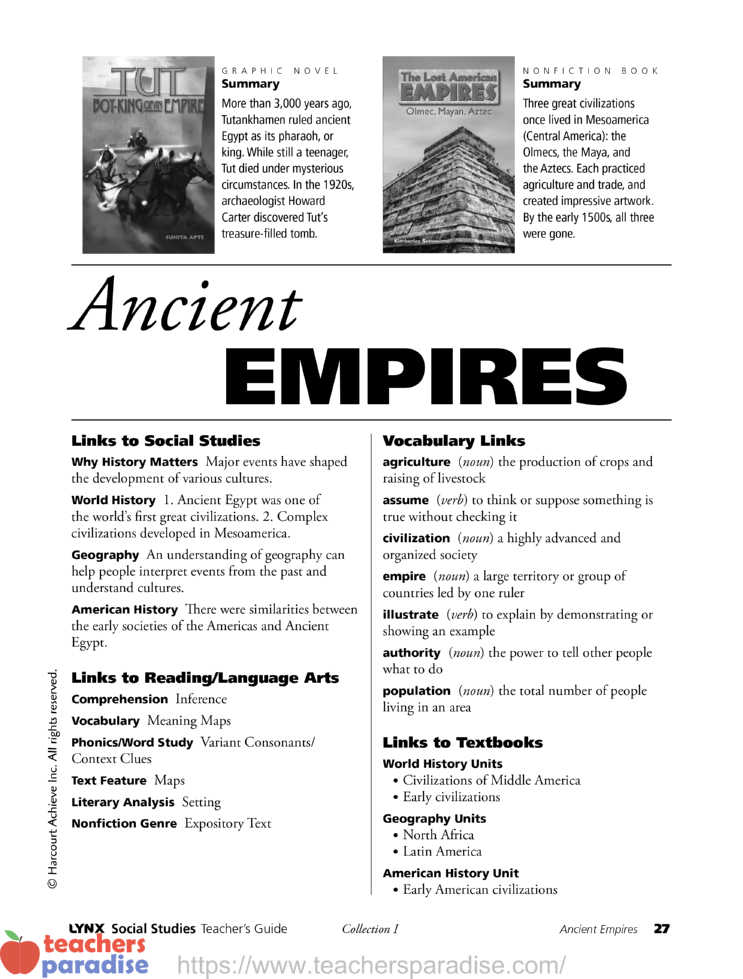
Links to Reading/Language Arts
Comprehension Inference
Vocabulary Meaning Maps
Phonics/Word Study Variant Consonants/Context Clues
Text Feature Maps
Literary Analysis Setting
Nonfiction Genre Expository Text
Vocabulary Links
agriculture (noun) the production of crops and raising of livestock
assume (verb) to think or suppose something is true without checking it
civilization (noun) a highly advanced and organized society
empire (noun) a large territory or group of countries led by one ruler
illustrate (verb) to explain by demonstrating or showing an example
authority (noun) the power to tell other people what to do
population (noun) the total number of people living in an area
Links to Textbooks
World History Units
• Civilizations of Middle America
• Early civilizations
Geography Units
• North Africa
• Latin America
American History Unit
• Early American civilizations
Ancient Empires GRAPHIC NOVEL
STEP 1 Introduce Theme
Make a Personal Connection
Ask Have you heard about, visited, or lived in a country that had a king or a queen? How is a king or queen different from a president? Tell students that kings and queens are like other leaders, but their positions are inherited and not elected.
Build Theme Background
Explain that kings known as pharaohs ruled Ancient Egypt. Ask What is the job of government leaders in the United States? (make laws, raise taxes, maintain armies) Review the Big Ideas on page 2 and discuss with students.
Preview Text
Distribute copies of Tut, Boy-King of an Empire, and discuss the cover. Ask How would you describe Tut? Who are the people in the background? How does this scene look different from our time and country?
• Preview what the mummy says on pages 2 and 3.
• Have students preview pages 4–11 and make their own predictions about the characters and story.
STEP 2 Build Word Power
Teach Vocabulary Strategy: Meaning Maps
Introduce the vocabulary words on page 3. Write these sentences on the board Agriculture is very important to our country. I am cutting taxes to help our farmers.
• Create a meaning map with headings like the one on page 30 of this guide. Have students suggest meanings for agriculture. Have a volunteer look up the definition. Invite others to create new sentences for agriculture. Finally, ask students to draw a picture to help them remember the meaning.
Review Phonics: Variant Consonant /f/
Explain to students that f and ph represent the sound /f/, as in the words foot and phone. Point out that gh can also make the sound /f/ at the end of words. Write foot, phone and rough. Model blending the sounds in these words.
• Say five, phrase, graph, and enough with students, first sound by sound, then the whole word. Next, write the words on the board. Ask Which letter or letters make the sound /f/?
• Ask students to turn to pages 6–7 and identify words with the /f/ sound. (fun, enough, pharaohs)
Support English Language Learners: Homophones
Explain to students that homophones are words that sound alike but are spelled differently and have different meanings.
• Write The girl wanted to eat two pieces of cake. Ask why the underlined words are homophones. (They sound alike but are spelled differently and have different meanings.)
• Preview other homophones the students may encounter in this book, such as made (maid) and by (buy).
STEP 3 Build Reading Power
Teach Comprehension Strategy: Inference
Tell students that sometimes they will need to make inferences as they read. They will supply information that is not directly stated in the text from clues in the story and from their own knowledge. Clues often give information about time, place, and setting, as well as people’s actions, opinions, and reactions.
Model Comprehension Strategy: Inference
Write the sentences The great hall was decorated with silver and gold objects. A farmer stood near the king. He lowered his eyes and whispered. Ask How do the underlined words in the first sentence help you infer that this scene takes place in the palace? What can you infer from the underlined words in the last sentence?
Begin Reading Tut, Boy-King of an Empire
Have students read pages 1–13. Remind students to make inferences as they read.
Apply Comprehension Strategy
On page 7, point out that Tutankhamen wants to race instead of learning his lessons for the day. Ask What can you infer about Tut based on these clues? (He’s still a child; He gets to do what he wants, etc.)
STEP 4 Support Understanding
Show Literacy in Action: Maps
Point out the map on page 10. Ask Why did Carter need a map? (to help him find Tutankhamen’s tomb) Encourage students to discuss how people use maps today to locate places they’ve never been and to learn about distant places.
Focus on Literary Analysis: Setting The setting is the place and time in which a story takes place. Details in the story give clues about the setting. These details may include the clothing, transportation, customs, or speech of the people. The setting also affects the moods in different scenes. Ask students to describe the setting on various pages.
Accommodate for Learning Differences: Oral Descriptions
Ask students to study pages 5 and 20, paying close attention to the illustrations. Have other students close their books while one volunteer describes an object from the page in detail. Repeat this process. Ask Are these objects things you might see today? Explain that these objects tell them that the story takes place a long time ago.
Finish Reading Tut, Boy-King of an Empire
Remind students to confirm or revise their earlier predictions about the story and the characters.
STEP 5 Wrap Up Graphic Novel
Discuss Tut, Boy-King of an Empire
Lead a class discussion using the following prompts:
• What can you infer about the cause of Tut’s death after reading this version of his story?
• How do you think the story might be different if it was set in America about two hundred years ago?
Practice Master 1
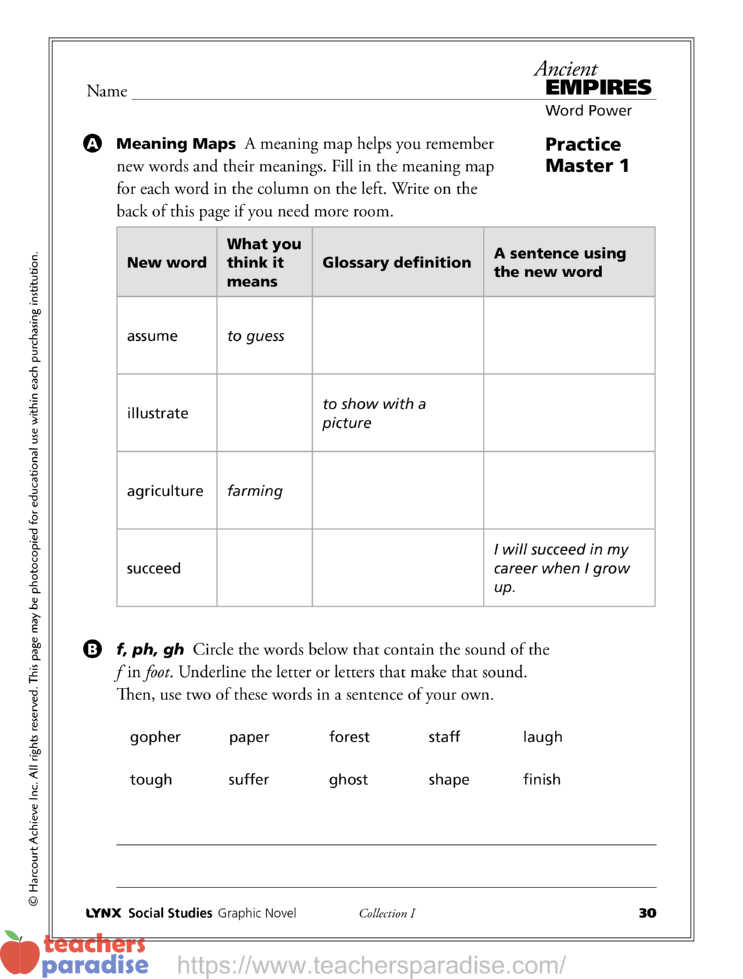
A. Meaning Maps
A meaning map helps you remember new words and their meanings. Fill in the meaning map for each word in the column on the left. Write on the back of this page if you need more room.
B. f, ph, gh
Circle the words below that contain the sound of the f in foot. Underline the letter or letters that make that sound. Then, use two of these words in a sentence of your own.
gopher paper forest staff laugh
tough suffer ghost shape finish
Practice Master 2
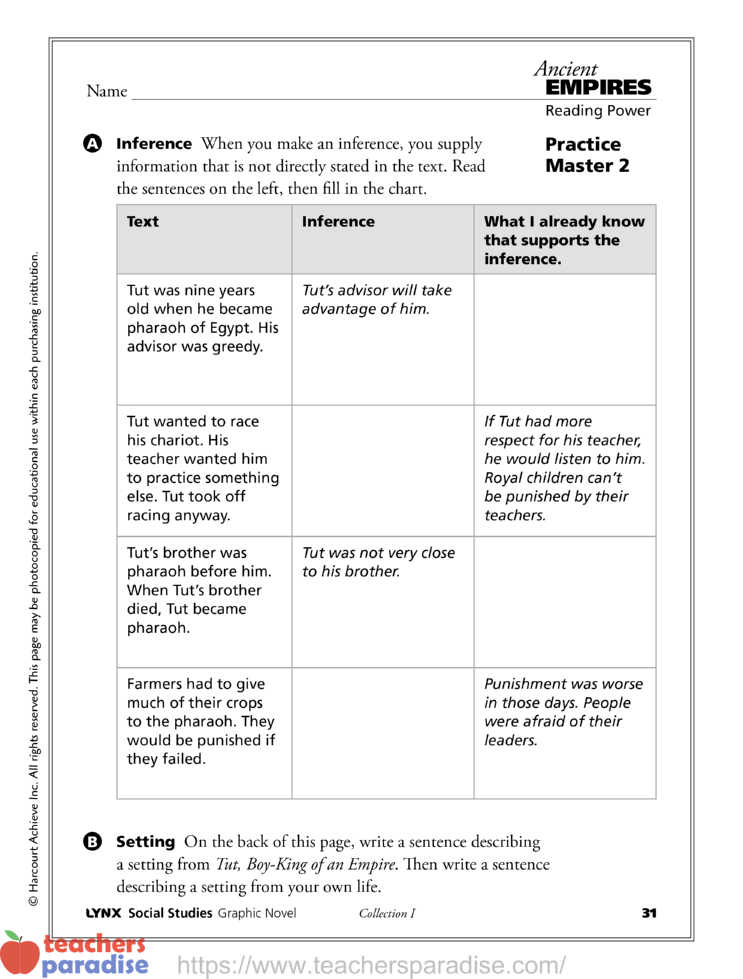
A. Inference
When you make an inference, you supply information that is not directly stated in the text. Read the sentences on the left, then fill in the chart.
B. Setting
On the back of this page, write a sentence describing a setting from Tut, Boy-King of an Empire. Then write a sentence describing a setting from your own life.
Ancient Empires NONFICTION BOOK
STEP 1 Connect Theme Across Texts
Build Prior Knowledge from Reading
Ask students What details about ancient Egypt do you remember from Tut, Boy-King of an Empire? Review pages 18 and 19. Ask students to share similarities and differences between their lives and those of the ancient Egyptians.
STEP 2 Build Word Power
Review Vocabulary Strategy: Meaning Maps
Introduce the new vocabulary words authority and population. Create a meaning map (as in Step 2 for the graphic novel) for authority.
• Have students work together to create a meaning map for population.
Teach Word Study Strategy: Context Clues
Good readers use context clues in text to help them find the meanings of unfamiliar words.
• Write artifacts on the board. Direct students’ attention to the word artifacts in the last paragraph of page 5 of The Lost American Empires. In surrounding sentences, they can find context clues that will help them determine the word’s meaning. Say What are some examples of artifacts listed in the third paragraph? (stone heads, pyramids, clay pots, etc.) Discuss with students how these clues help them determine the meaning of the word.
Support English Language Learners: Map Words
Review Comprehension Strategy: Inference
Remind students that they make inferences when they determine what has happened in a text without the author specifically telling them. Read pages 4–7 together. Ask students to make an inference based on the reading. (How did Europeans feel about the discovery of the New World? What do these artifacts teach us about ancient civilizations?)
STEP 3 Begin Reading The Lost American Empires
Have students read chapters 1 and 2 on their own. Remind students to use what they’ve learned so far as they read.
Link to Student Research Topics
To learn more, students can investigate:
• Tenochtitlán, the capital of the Aztec empire
• ancient cultures in other parts of the world
• other archeological sites in Central America and Egypt
STEP 4 Support Understanding
Focus on Nonfiction Genre: Expository Text
Explain to students that expository text gives information. Its topic and purpose are generally stated at the beginning of each section. The rest of the writing presents details, examples, and facts about the topic. Explain that most of The Lost American Empires is expository text. It gives information about the ancient cultures of Mesoamerica.
Focus on Text Feature: Maps
Explain to students that maps can help them learn a lot about a place they are studying. Have students look at the map on page 7. Ask them to read the title of the map. Ask What information does this map give? (where and when the empires of Mesoamerica existed)
Accommodate for Learning Differences: Maps
Have students trace the map on page 7 of The Lost American Empires. Have them shade the region that belonged to the Olmecs, the Maya, and the Aztecs in different colors. Ask them to create a map key that tells what each color means.
Finish Reading The Lost American Empires
Remind students to use what they have learned as they read.
STEP 5 Wrap Up Theme
Discuss The Lost American Empires
Encourage students to discuss the following questions:
• How were the Olmecs, Maya, and Aztecs alike and different? Make an inference about what life was like in one of those cultures.
• How could a travel agent use maps to encourage you to travel?
• You want to sell an article you wrote about the Olmecs, Maya, or Aztecs.
Write two sentences showing the editor what you know about that culture.
Link to Why History Matters
Ancient civilizations have similarities and differences. For example, the cultures in Tut, Boy-King of an Empire and The Lost American Empires all relied on agriculture to survive. In each of these societies, farmers grew crops to feed many people, not just themselves. Discuss how this allowed leaders, builders, and other workers to specialize and contribute to the advancement of the civilization. Discuss also how these cultures developed different traditions and beliefs.
Analyze and Write Across Texts
Ask students to use both books to create a chart containing artifacts from each of the four civilizations: Egyptian, Olmec, Mayan, and Aztec.
• Ask students to study the chart and draw an inference about one of these cultures. They can use the inference in a short essay about that lost empire. Have them refer to Practice Master 5 and their chart to organize their ideas.
Link Theme to Textbook
Preview the headings, images, captions, and subtitles in: World History Units on civilizations of Middle America and early civilizations; Geography Units on North Africa and Latin America; or American History Units on early American civilizations. Have students make predictions based on what they’ve learned. Predictions can be revised or confirmed during reading.
Practice Master 3
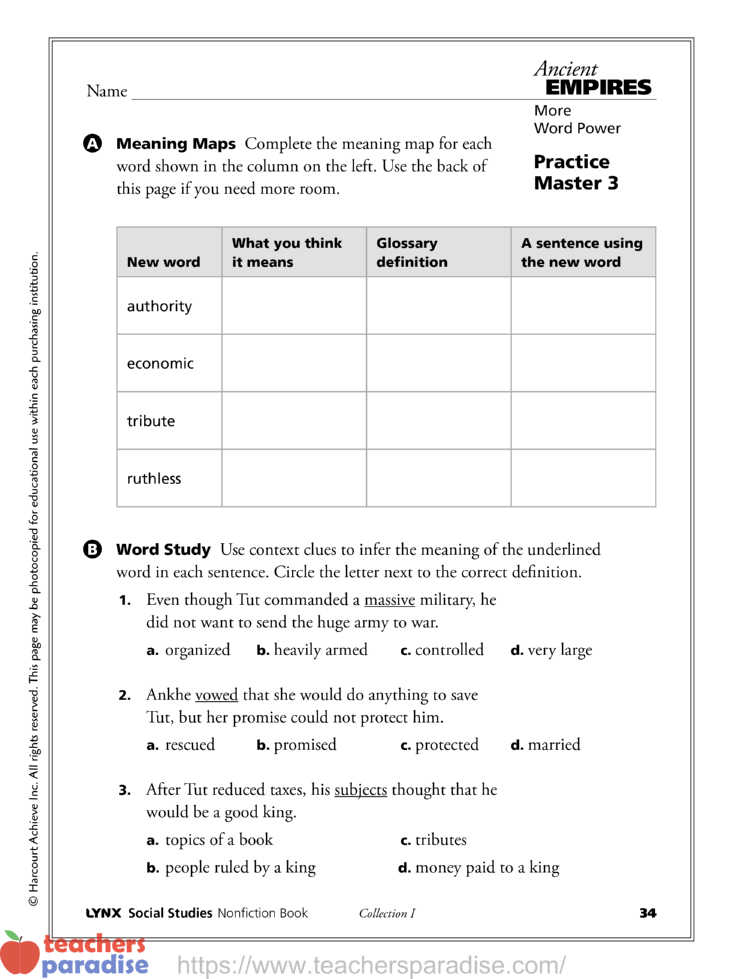
A. Meaning Maps
Complete the meaning map for each word shown in the column on the left. Use the back of this page if you need more room.
B. Word Study
Use context clues to infer the meaning of the underlined word in each sentence. Circle the letter next to the correct definition.
- Even though Tut commanded a massive military, he did not want to send the huge army to war.
a. organized b. heavily armed c. controlled d. very large - Ankhe vowed that she would do anything to save Tut, but her promise could not protect him.
a. rescued b. promised c. protected d. married - After Tut reduced taxes, his subjects thought that he would be a good king.
a. topics of a book b. people ruled by a king c. tributes d. money paid to a king
Practice Master 4
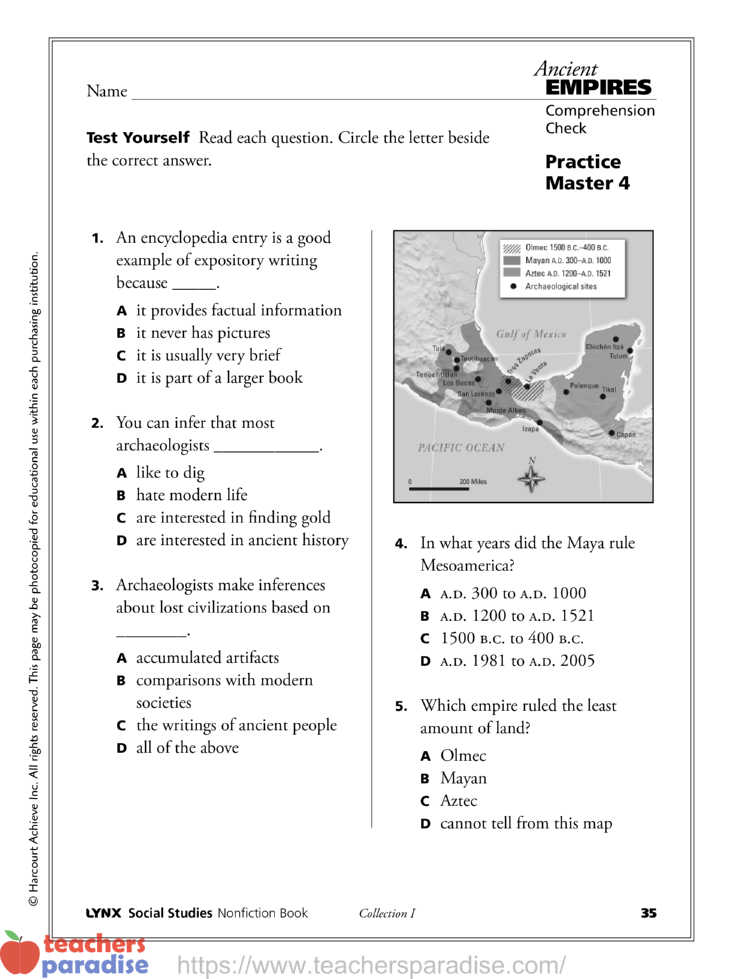
Test Yourself
Read each question. Circle the letter beside the correct answer.
- An encyclopedia entry is a good example of expository writing because _.
A it provides factual information
B it never has pictures
C it is usually very brief
D it is part of a larger book - You can infer that most archaeologists __.
A like to dig
B hate modern life
C are interested in finding gold
D are interested in ancient history - Archaeologists make inferences about lost civilizations based on __.
A accumulated artifacts
B comparisons with modern societies
C the writings of ancient people
D all of the above - In what years did the Maya rule Mesoamerica?
A a.d. 300 to a.d. 1000
B a.d. 1200 to a.d. 1521
C 1500 b.c. to 400 b.c.
D a.d. 1981 to a.d. 2005 - Which empire ruled the least amount of land?
A Olmec
B Mayan
C Aztec
D cannot tell from this map
Practice Master 5
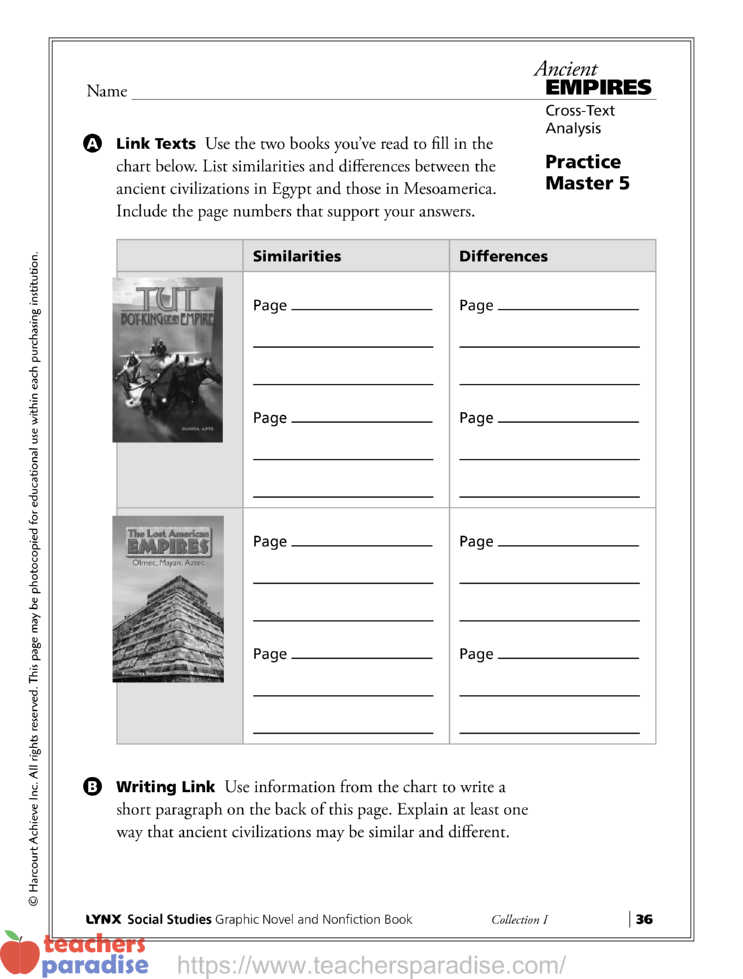
A. Link Texts
Use the two books you’ve read to fill in the chart below. List similarities and differences between the ancient civilizations in Egypt and those in Mesoamerica. Include the page numbers that support your answers.
B.
Writing Link Use information from the chart to write a short paragraph on the back of this page. Explain at least one way that ancient civilizations may be similar and different.
LYNX Ancient Empires – Answer Key
